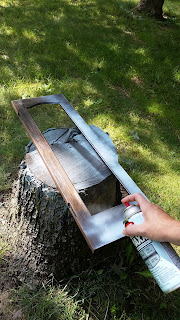For the finish: Minwax Provincial Stain
White Paint
Water
Minwax Polycrilic
paint brush and/or foam brushes, clean rag/towel and tub for mixing paint and water
I finally talked my husband into building a
farmhouse table from Ana-white.com. I wanted to share the results with you and explain how I did the finish.
Here's the table and a bench in the making. We made this one 7 feet long rather than the 8 feet that the original plan calls for.
For the finish. I sanded it down with a random orbital sander first with a coarse grit and then with a fine grit paper. Then I brushed on one coat of Minwax Provincial Stain and let dry over night.
 |
| Stain complete. |
 |
| This was my practice board for the white wash. |
 |
| Stain and part of white wash. |
Once the stain was dry. I mixed Color Place semi-gloss white paint (only because that's the white paint I had on hand; pretty much any white- or whatever color you want to try- paint will do.) with water in an old ice cream tub. I mixed about 1 part paint to 3 parts water. For more white, add more paint, for less white, add more water or less paint. You can practice on a spare piece of wood or underside of furniture until you obtain desired look. Once mixture is complete, paint on the watered down paint with a brush or foam brush and wipe off immediately with a clean rag/towel. I used an old "flour sack" towel (those can be purchased at Walmart in the kitchen towel section). The harder you wipe, the less white will be left, the less you wipe, the whiter it will turn out. You can just see how it goes and what you like best while applying it. If it ends up too white, or to clean up drips and runs that are still moist, you can either get your cloth wet with clean water and wipe off, or sand down when it's all dry. If you decide you want more white when it's all dry then just repeat the process.

When the wash was all dry. We sealed with several coats of Minwax Polycrilic. The Polycrilic is water based, dries very fast, is very easy to clean up and virtually has no odor. Here's the final look.
And the bench. I made the top whiter because it was redder wood resulting in a different stain color. I did end up sanding that down once I compared it to the table and now it looks great! (Sorry I don't have a picture of the two together finished. We were anxious to get the table into the friends' house before the bench was complete.)
Notes in making this table:
1- On the table, we didn't screw the top onto the legs but after moving it into the house, joined the top to the legs with large L-brackets.
2- After using the Kreg Jig, I had a hard time getting the pocket hole plugs to go in. I ended up using a nail driver and hammer to knock them in and it worked great!
3- On the bench, the pockets created with the Kreg Jig were too small for the plugs because the board was only 1 inch thick. So after much hassle, I finally created something to shorten the existing plugs. I used the Jig drill to create several holes in a spare piece of 2x4. I drilled to a depth that would hold the plugs but not lose them down in it.
Then, I inserted the plugs upside down into the created holes until they were firmly in place but not damaging the tips. Once they were set, I sanded the ends with a rough gritted orbital sander until they were the correct length for the pocket holes.
 |
| Here they are inserted. They got pretty banged up in all my efforts to get them in before coming up with this system. :) |
If some were just a tad high, they sanded down nicely once they were set into the bench.

























































